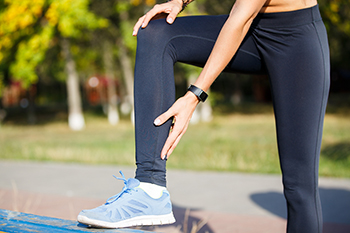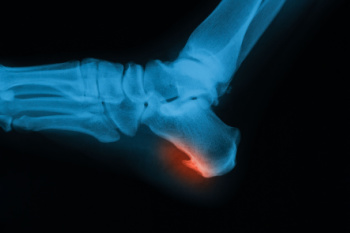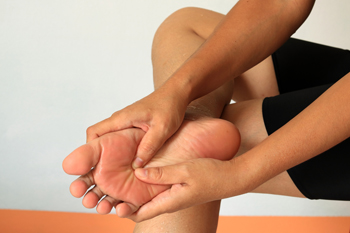Items filtered by date: June 2024
What is Achilles Tendinopathy?
 Achilles tendinopathy is a condition characterized by pain, swelling, and stiffness in the Achilles tendon, which connects the calf muscles to the heel bone. This condition often results from overuse, particularly in athletes and individuals who engage in repetitive activities such as running or jumping. It can also arise from a sudden increase in physical activity, wearing poor footwear, or biomechanical issues like flat feet. The pain associated with Achilles tendinopathy usually starts as a mild ache above the heel or in the back of the leg, worsening with activity. The condition can range from mild inflammation to more severe degeneration of the tendon fibers. Diagnosis typically involves a physical examination and imaging tests, such as ultrasound or MRI scans to assess the extent of the damage. Treatment options include rest, targeted exercises, and nonsteroidal anti-inflammatory drugs. In severe cases, surgery may be required to repair the tendon. Preventative measures include proper warm-up routines, wearing appropriate footwear, and gradually increasing the intensity of physical activity. If you experience symptoms of Achilles tendinopathy, it is suggested that you schedule an appointment to see a podiatrist for an accurate diagnosis and effective treatment plan.
Achilles tendinopathy is a condition characterized by pain, swelling, and stiffness in the Achilles tendon, which connects the calf muscles to the heel bone. This condition often results from overuse, particularly in athletes and individuals who engage in repetitive activities such as running or jumping. It can also arise from a sudden increase in physical activity, wearing poor footwear, or biomechanical issues like flat feet. The pain associated with Achilles tendinopathy usually starts as a mild ache above the heel or in the back of the leg, worsening with activity. The condition can range from mild inflammation to more severe degeneration of the tendon fibers. Diagnosis typically involves a physical examination and imaging tests, such as ultrasound or MRI scans to assess the extent of the damage. Treatment options include rest, targeted exercises, and nonsteroidal anti-inflammatory drugs. In severe cases, surgery may be required to repair the tendon. Preventative measures include proper warm-up routines, wearing appropriate footwear, and gradually increasing the intensity of physical activity. If you experience symptoms of Achilles tendinopathy, it is suggested that you schedule an appointment to see a podiatrist for an accurate diagnosis and effective treatment plan.
Achilles tendon injuries need immediate attention to avoid future complications. If you have any concerns, contact Kimberly Woodard, DPM of Pinnacle Foot and Ankle Centers, LLC . Our doctor can provide the care you need to keep you pain-free and on your feet.
What Is the Achilles Tendon?
The Achilles tendon is a tendon that connects the lower leg muscles and calf to the heel of the foot. It is the strongest tendon in the human body and is essential for making movement possible. Because this tendon is such an integral part of the body, any injuries to it can create immense difficulties and should immediately be presented to a doctor.
What Are the Symptoms of an Achilles Tendon Injury?
There are various types of injuries that can affect the Achilles tendon. The two most common injuries are Achilles tendinitis and ruptures of the tendon.
Achilles Tendinitis Symptoms
- Inflammation
- Dull to severe pain
- Increased blood flow to the tendon
- Thickening of the tendon
Rupture Symptoms
- Extreme pain and swelling in the foot
- Total immobility
Treatment and Prevention
Achilles tendon injuries are diagnosed by a thorough physical evaluation, which can include an MRI. Treatment involves rest, physical therapy, and in some cases, surgery. However, various preventative measures can be taken to avoid these injuries, such as:
- Thorough stretching of the tendon before and after exercise
- Strengthening exercises like calf raises, squats, leg curls, leg extensions, leg raises, lunges, and leg presses
If you have any questions please feel free to contact our office located in Port St. Lucie, FL . We offer the newest diagnostic tools and technology to treat your foot and ankle needs.
Reminder: When Was the Last Time...?
What Is Cuboid Syndrome?
 Cuboid syndrome is a foot condition characterized by pain on the lateral side of the foot, caused by the displacement or subluxation of the cuboid bone. This bone is one of the seven tarsal bones in the foot and plays a significant role in stability and movement. Cuboid syndrome typically occurs due to repetitive strain, overuse, or an acute injury such as an ankle sprain. Though not as common as other foot injuries, cuboid syndrome is often seen in athletes, particularly dancers and runners, due to the high impact and stress placed on their feet. The pain is usually sharp and localized around the cuboid bone, exacerbated by weight-bearing activities and certain movements like pushing off the ground. Diagnosis involves a physical examination, focusing on the foot's range of motion and palpation to identify tenderness over the cuboid bone. Imaging tests are rarely necessary but may be used to rule out other conditions. Risk factors include wearing improper footwear, overtraining, having flat feet, or a pronated foot type. Treatment typically involves rest and manual manipulation of the cuboid bone, along with orthotic devices for support. If you have pain in this area of your foot, it is suggested that you schedule an appointment with a podiatrist for an accurate diagnosis and effective treatment plan.
Cuboid syndrome is a foot condition characterized by pain on the lateral side of the foot, caused by the displacement or subluxation of the cuboid bone. This bone is one of the seven tarsal bones in the foot and plays a significant role in stability and movement. Cuboid syndrome typically occurs due to repetitive strain, overuse, or an acute injury such as an ankle sprain. Though not as common as other foot injuries, cuboid syndrome is often seen in athletes, particularly dancers and runners, due to the high impact and stress placed on their feet. The pain is usually sharp and localized around the cuboid bone, exacerbated by weight-bearing activities and certain movements like pushing off the ground. Diagnosis involves a physical examination, focusing on the foot's range of motion and palpation to identify tenderness over the cuboid bone. Imaging tests are rarely necessary but may be used to rule out other conditions. Risk factors include wearing improper footwear, overtraining, having flat feet, or a pronated foot type. Treatment typically involves rest and manual manipulation of the cuboid bone, along with orthotic devices for support. If you have pain in this area of your foot, it is suggested that you schedule an appointment with a podiatrist for an accurate diagnosis and effective treatment plan.
Cuboid syndrome, also known as cuboid subluxation, occurs when the joints and ligaments near the cuboid bone in the foot become torn. If you have cuboid syndrome, consult with Kimberly Woodard, DPM from Pinnacle Foot and Ankle Centers, LLC . Our doctor will assess your condition and provide you with quality foot and ankle treatment.
Cuboid syndrome is a common cause of lateral foot pain, which is pain on the outside of the foot. The condition may happen suddenly due to an ankle sprain, or it may develop slowly overtime from repetitive tension through the bone and surrounding structures.
Causes
The most common causes of cuboid syndrome include:
- Injury – The most common cause of this ailment is an ankle sprain.
- Repetitive Strain – Tension placed through the peroneus longus muscle from repetitive activities such as jumping and running may cause excessive traction on the bone causing it to sublux.
- Altered Foot Biomechanics – Most people suffering from cuboid subluxation have flat feet.
Symptoms
A common symptom of cuboid syndrome is pain along the outside of the foot which can be felt in the ankle and toes. This pain may create walking difficulties and may cause those with the condition to walk with a limp.
Diagnosis
Diagnosis of cuboid syndrome is often difficult, and it is often misdiagnosed. X-rays, MRIs and CT scans often fail to properly show the cuboid subluxation. Although there isn’t a specific test used to diagnose cuboid syndrome, your podiatrist will usually check if pain is felt while pressing firmly on the cuboid bone of your foot.
Treatment
Just as the range of causes varies widely, so do treatments. Some more common treatments are ice therapy, rest, exercise, taping, and orthotics.
If you have any questions, please feel free to contact our office located in Port St. Lucie, FL . We offer the newest diagnostic and treatment technologies for all your foot care needs.
Choosing the Right Running Shoes for Your Needs

When it comes to running, selecting the appropriate footwear is essential for comfort, performance, and injury prevention. For long-distance running, cushioned shoes with ample support are ideal to absorb shock and reduce fatigue, enhancing endurance. Trail running demands shoes with rugged outsoles and superior traction to navigate uneven terrain and provide stability on rocky paths. If you are into sprinting or track running, lightweight shoes with minimal cushioning and a snug fit promote agility and speed. Cross-training shoes offer versatility for various activities, blending features suitable for running, jumping, and lateral movements. For those with overpronation or flat feet, motion-control shoes with reinforced arch support help correct gait imbalances and prevent injuries. Conversely, neutral shoes suit runners with normal pronation, offering balanced cushioning and support. If you have developed pain from wearing the wrong type of running shoes, it is suggested that you visit a podiatrist who can treat any foot ailment, and educate you about what type of shoes to purchase for your running style.
You should always make sure your running shoes fit properly in order to avoid injury. For more information, contact Kimberly Woodard, DPM from Pinnacle Foot and Ankle Centers, LLC . Our doctor can provide the care you need to keep you pain-free and on your feet.
Choosing the Right Running Shoe for Your Foot Type
Improper shoe sizing can cause a myriad of problems for your feet. Shoes that don’t fit you properly can lead to muscular imbalances in your body, which can result in foot, knee, and hip injuries.
Tips for Finding the Right Running Shoe
- Make sure you have a thumb’s width of wiggle room between the end of your longest toe and the front of the shoe.
- There should be little to no slipping at the heel
- Don’t assume your size in one shoe brand will be your size in another
- Do not lace up your shoes too tightly
- Walk around in the store with your new shoes before you buy them
If you have any questions please feel free to contact our our office located in Port St. Lucie, FL . We offer the newest diagnostic and treatment technologies for all your foot and ankle needs.
Reasons for Pins and Needles in the Feet

Experiencing a type of foot pain that feels like pins and needles in your feet can be quite disconcerting. This prickling, tingling, or numb sensation occurs when the nerves in your feet are deprived of adequate blood supply. It commonly happens when pressure is exerted on the feet, such as from sitting or sleeping in an awkward position. While this sensation typically subsides once you adjust your posture and restore blood flow, persistent or recurrent episodes may indicate an underlying issue that warrants attention. Diabetes, Raynaud's phenomenon, hyperventilation, sciatica, or multiple sclerosis can contribute to the onset of pins and needles. A podiatrist can perform tests to find out what is causing this tingling sensation by identifying the root cause of your symptoms. With their expertise, a podiatrist can then develop a personalized treatment plan tailored to your specific needs. Some lifestyle adjustments or medication may be suggested. Do not let persistent pins and needles disrupt your daily life. If this applies to you, it is suggested that you schedule an appointment with a podiatrist for a comprehensive evaluation and effective management of your foot discomfort.
Foot Pain
Foot pain can be extremely painful and debilitating. If you have a foot pain, consult with Kimberly Woodard, DPM from Pinnacle Foot and Ankle Centers, LLC . Our doctor will assess your condition and provide you with quality foot and ankle treatment.
Causes
Foot pain is a very broad condition that could be caused by one or more ailments. The most common include:
- Bunions
- Hammertoes
- Plantar Fasciitis
- Bone Spurs
- Corns
- Tarsal Tunnel Syndrome
- Ingrown Toenails
- Arthritis (such as Gout, Rheumatoid, and Osteoarthritis)
- Flat Feet
- Injury (from stress fractures, broken toe, foot, ankle, Achilles tendon ruptures, and sprains)
- And more
Diagnosis
To figure out the cause of foot pain, podiatrists utilize several different methods. This can range from simple visual inspections and sensation tests to X-rays and MRI scans. Prior medical history, family medical history, and any recent physical traumatic events will all be taken into consideration for a proper diagnosis.
Treatment
Treatment depends upon the cause of the foot pain. Whether it is resting, staying off the foot, or having surgery; podiatrists have a number of treatment options available for foot pain.
If you have any questions, please feel free to contact our office located in Port St. Lucie, FL . We offer the newest diagnostic and treatment technologies for all your foot care needs.

